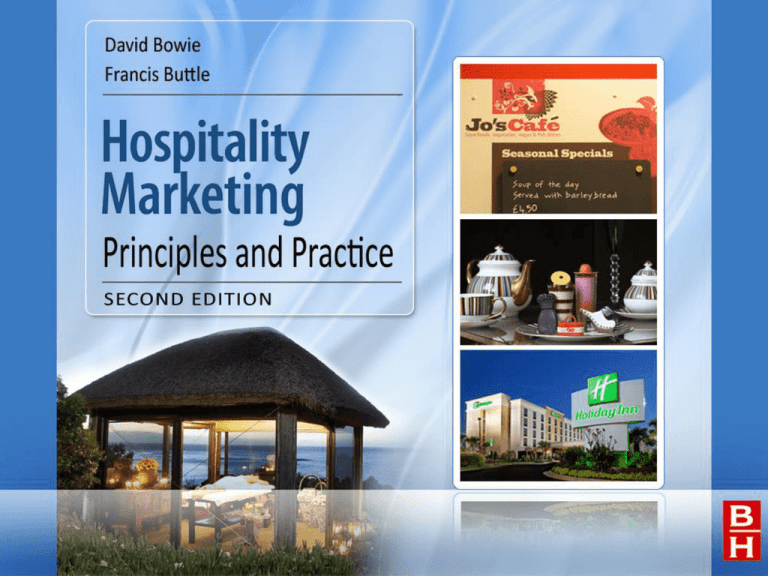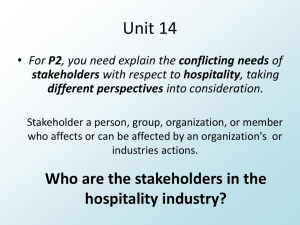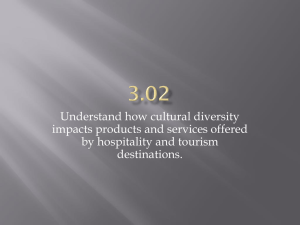Consumer behaviour in tourism
advertisement

Chapter 3 Understanding and segmenting customers After going through this chapter, you should be able to: * Understand a number of core concepts that explain hospitality consumer and organizational customers’ behaviour * Discuss the role of customer expectations * Identify the factors that influence the hospitality consumer, buyer and organizational customer decision-making process * Explain the principles of segmenting demand in hospitality markets * Describe hospitality segmentation variables * Evaluate the characteristics of hospitality target markets Marketers study consumer behaviour to understand and predict what customers will buy, how and why Marketers need to understand the processes consumers go through in buying and consuming hospitality products. If we can understand who buys which hospitality products where, when and why, then we can influence demand By understanding and meeting customer expectations, companies can better deliver customer satisfaction Key economic factor is consumer disposable income When there is: * strong economic growth * low employment opportunities * higher consumer confidence - then there is an increase in consumption When there is: * economic downturn/recession * low employment opportunities * lower consumer confidence - then there is a decrease in consumption Individual consumer buyer behaviour can be categorized into: * socio-cultural influences * individual differences * contextual circumstances Figure 3.1 Influences on individual hospitality consumers Consumers’ perception of the risk associated with buying a hospitality product influences the purchase decision Financial risk When large amount of money at stake - major hospitality purchases Social risk When hospitality products that have social significance for consumer Psychological risk When consumers perceive a threat to their selfimage and self-esteem Consumers vary regarding the level of involvement they have in purchasing decisions A high-involvement purchase decision is one that is personally significant/relevant A low-involvement purchase decision is a routine decision with limited significant/relevance Involvement tends to vary between: * individuals (some people are highly involved in many decisions) * products (some products are more involving than others) context (the level of involvement can vary across purchasing contexts) 1. consumer identifies a need 2. need may be caused by internal conditions or external stimuli 3. low-involvement product = routinized buying decision 4. high-involvement product = search for information to make decision 5. search process can be internal or external: * An internal search uses memory to recall previous experiences (or information) to provide solution * If the internal search does not provide a solution, then the consumer engages in external search * Consumers evaluate alternatives and make decision Customers have expectations of hospitality encounters, which marketers must meet if customers are to be satisfied Zones of tolerance: * Ideal level – ‘what can be’ * Desired level – ‘what should be’ * Predicted level – ‘what will be’ * Minimum tolerable – ‘what must be’. Factors influencing customer’s zone of tolerance: * Customer’s personality and current circumstances * Importance of the purchase occasion * Characteristics of the product * Price Organizations have a different approach to the buying process compared with individual consumers - differences include: * number of participants involved in the organization’s purchase * users are not always the buyers * complexity of the arrangements (numbers, travel, accommodation, catering and entertainment * technical requirements The ‘decision making unit’ (DMU): Users are the customers who consume hospitality products Influencers are people who influence any part of the decision Deciders are the people who actually make the purchase decisions Buyers are the people who make and pay for the booking Gatekeepers are people who control the flow of information to other members of the DMU Segmentation is the starting point for developing effective marketing strategies because: * trying to target all consumers is not cost-effective * identifying the characteristics of target markets means the hospitality offer can be designed to satisfy customers more effectively * providing a more focused and cost-effective marketing strategy improves profitability by maximizing customer satisfaction, generating repeat and recommended sales * Specify the market * Establish segmentation criteria * Generate segmentation variables * Evaluate market segment profiles * Evaluate company’s competences to serve selected segments Figure 3.2 Hospitality market segments The primary segmentation variable is purpose of travel Three main categories are: * business * leisure * visiting friends and relatives (VFR) Each of these main categories can be subdivided into several distinct market segments Key point is that the same person can have different customer needs and wants depending on whether the purpose of travel is business, non-business or VFR Accommodation business customers tend to: * be less price sensitive, employer pays for hospitality and travel expenses * have shorter stays (one night or only a few) * be more frequent, or regular, users of hotel accommodation * stay at establishments that are within a reasonable (5– 3 0 min) travel time of their place of work less seasonal Accommodation leisure customers tend to: * be more price sensitive than business travellers, since they are paying for the accommodation out of their own after-tax income * be more likely to stay longer on each trip * be less-frequent users of hotel accommodation (unless also business travellers) * stay at establishments that are close to leisure amenities and tourist attractions * be much more seasonal Geographic Age Family size/structure Ethnic origin, religion and nationality Price/product Brand loyalty Size of party Time Demographic Gender Socio-economic class Buyer needs and benefits Current user status Purchase occasion Lifestyle (or psychographics) Figure 3.3 Guest usage status Companies need to evaluate the potential of market segments using the following criteria: Market data – size, growth, accessibility, consumer needs and wants and benefits sought, customer power; Competitor analysis – number of competitors, their market share, capabilities, resources, strengths and weaknesses, differentiators and profitability and the potential for new entrants; Internal company audit – capability of servicing the market segment, compatibility with existing and future segments, and compatibility with the company’s resources and values Consumer target markets: * Families * International outbound market – e.g. China * Seniors market Organizational target markets * Corporate travel * MICE – meetings; incentive; conferences; exhibitions * Aircrew * Tour groups * SMERFE - social, military, educational, religious, fraternal and ethnic * Intermediaries Figure 3.4 Best Western advert targeting classical music lovers Bowen, D., & Clarke, J. (2009). Contemporary tourist behaviour: Yourself and others as tourists. CABI Publishing Cai, L.A., Li, M., & Knutson, B. J. (2007). Research on China outbound market: A meta-review. Journal of Hospitality and Leisure Marketing, 16 , 5 – 20 Cooper, C., Fletcher, J. , Fryall, A., Gilbert, D., & Wanhill, S. (2008). Tourism (4th ed.). Financial Times/Prentice Hall Judge, T. A., Higgins, C. A., Thoresen, C. J., & Barrick, M. R. (1999). The big five personality traits, general mental ability, and career success across the life span. Personnel Psychology, 52, 3 Levitt, T. (1983). The globalization of markets. Harvard Business Review, 38 , 45 – 56 March, R. , & Woodside, A. G. (2005). Tourism behaviour. CABI Publishing Osman, H. (2001). Practice of relationship marketing in hotels. PhD Thesis, Oxford Brookes University Pan, G. W. , & Laws, E. (2002). Tourism marketing opportunities for Australia in China. Journal of Vacation Marketing, 8, 39 – 48 Swarbrooke, J., & Horner , S. (2006). Consumer behaviour in tourism, Butterworth-Heinemann Usunier , J. C., & Lee , J. (2009). Marketing across cultures (5th ed.) Financial Times /Prentice Hall www.euromonitorinternational.co (2010) Zeithaml V. A., Berry , L. L., & Parasuraman, A. (1993). The nature and determinants of customer expectations of service. Journal of the Academy of Marketing 21, 1 – 12






